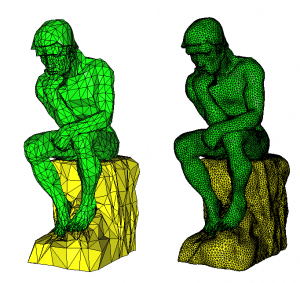Starting from a rough mesh representing the thinker of Rodin (and named rodin.mesh) we want to improve its surface representation.
We use the -hausd option that controls the surface approximation and the -nr option that allows to specify that we don’t want to detect ridges along the surface:
- The hausdorff value is related to the mesh bounding box. The default value is of 0.01 and stands for a bounding box af size [1 x 1 x 1]. Here, the size of the mesh bounding box is of [0.6 x 0.4 x 1], thus, a hausdorff value of 0.001 allows to have a good surface representation.
More infos about the -hausd option. - The -nr option states that we don’t want to detect sharp edges during the initial analysis of the input triangulation, thus, the ideal reconstructed surface don’t contain ridges. Here the initial mesh is very poor and the “thinker” is a smooth surface so the -nr option avoid to detect triangulation artefacts.
The initial and final meshes are displayed figure 1.


